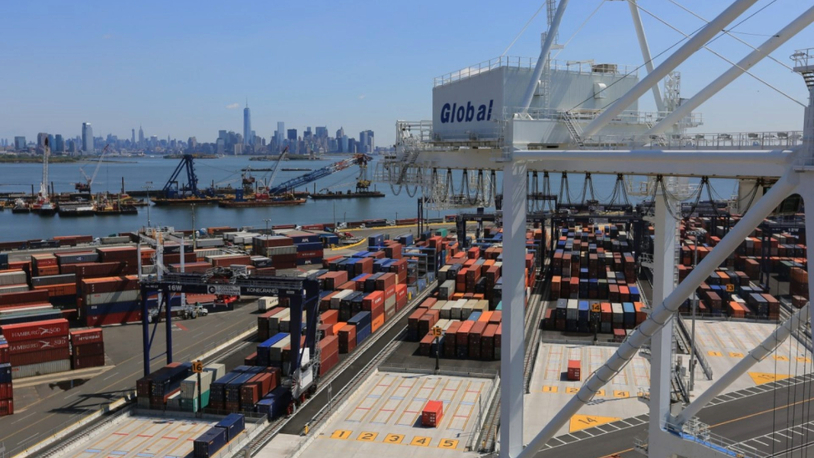Business Sectors
Events
Contents
Register to read more articles.
Shipping reacts to mass Trump tariffs and potential trade war
"Things are so chaotic right now that anything announced today could well be cancelled or watered down tomorrow," a shipping analyst remarked following the sweeping tariffs announced by US President Donald Trump on 2 April
Declaring a "national emergency" over the "lack of reciprocity in bilateral trade relationships," President Trump unveiled tariffs of at least 10% on all imports, affecting around 60 nations. China faces a reciprocal 34% tariff, which, when added to the existing 20% levy, brings the total to 54%. The European Union will see a 20% tariff, among other affected economies.
Industry experts are scrambling to assess the potential impact across different shipping sectors, but the question of further retaliation looms. If tariffs are instituted as announced, container vessels and car carriers would be expected to take the hardest hit, experts say, while dry bulk shipping could see more moderate effects. But as the potential for further escalation and a global trade war grows, so does the potential for deeper changes to the shipping industry’s trading landscape.
"These tariffs challenge established trade flows, urging companies to reconsider their strategies as cargo volumes potentially divert to alternative routes or markets," Optima Shipping Services head of market analysis and decarbonisation strategies Angelica Kemene told Riviera.
Container shipping giant Maersk cautioned it is too early to predict the impact of the unilateral US economic action or what the response might be from US trading partners affected by the tariffs.
"We need to see how countries will respond to these plans – and to what extent they choose to negotiate, impose counter-tariffs, adjust import duties, or pursue a combination of these measures," Maersk said.
Economic fallout from Trump’s tariffs: inflation and slower growth
Maersk acknowledged the severity of the tariffs announced from the White House, citing "volatility" from a "shifting policy landscape" as a challenge for exporters and importers, alike.
"The tariff plan announced by the US administration was significant, and in its current form, it clearly isn’t good news for the global economy, stability, and trade,” Maersk said. "As several scenarios remain possible, customers will need the ability to speed up or slow down goods and potentially redirect flows to alternative markets to keep their goods moving efficiently."
BIMCO chief shipping analyst Niels Rasmussen warned the tariffs will primarily hurt US businesses and consumers, which will face increased costs on nearly 80% of imports. Mr Rasmussen also predicted the measures would contribute to rising inflation and slower economic growth in the US that could in turn affect global markets.
A report from the OECD estimates a 10% increase in non-commodity US imports – matched by a similar 10% tariff increase by other nations on US exports – could lead to a 0.3% drop in global output within three years, while global inflation could rise by 0.4 percentage points per year.
With the announced tariffs already exceeding this 10% threshold, Mr Rasmussen warned that this, along with retaliatory measures, could push the economic impact even further.
Container shipping faces the biggest blow
Focusing on the shipping impact, Banchero Costa head of research Ralph Leszczynski told Riviera container shipping is the sector most vulnerable to the new tariffs.
"The US accounts for almost 20% of containerised trade, primarily longhaul shipments from East Asia," he explained. Tariffs will reduce demand from US consumers, forcing exporters to reroute goods. “Even if East Asian exports shift to Europe or other Asian markets, it would still result in shorter distances for the average container, which means bad news for shipowners", he added.
BIMCO’s Mr Rasmussen estimated if the tariffs halt US container import growth entirely, global container trade growth could slow by 0.5 percentage points.
Shippers to re-adjust
Ms Kemene noted shippers are already reassessing their supply chains, which could spark disruptive realignments and volatility in freight rates.
"Above all, these tariffs introduce profound uncertainty, prompting stakeholders to adopt cautious, adaptive measures that could dampen shipping activity in the short term," she noted, highlighting market speculation about voyage cancellations in May.
Maersk added that, prior to the tariff announcements, customers accelerated imports to the US and secured additional storage space. The liner giant expects, until more clarity emerges, customers will adopt a more cautious approach regarding their inventory levels.
Xeneta chief analyst Peter Sand pointed out the difficult timing for US shippers, as many are finalising long-term container freight contracts set to take effect on 1 May. "This places them in an extremely difficult position," Mr Sand noted.
Furthermore, he added, while tariffs will raise the overall landed cost of importing goods, the downward trend in ocean container spot rates since 1 January is likely to persist. “Once the tariff situation becomes clearer and shippers begin to diversify supply chains across regions, it is possible we could see disruption in ocean supply chains and upward pressure on rates, but this may be a little further down the line”.
Car carriers face immediate risk
The car carrier sector is also poised for disruption, as the US administration has imposed a 25% tariff on imported cars.
Bloomberg reports, while car imports and parts are exempt from the new reciprocal tariffs, car manufacturers are already feeling the pressure.
Regarding the shipping impact, Optima Shipping’s Ms Kemene stated that even a 10% drop in vehicle imports could remove demand equivalent to 40 car carriers, given the substantial volume of over 4M vehicles imported by sea to the US in 2024 alone.
Dry bulk impact hinges on retaliation
For the dry bulk sector, direct impacts from US tariffs may be limited, but retaliatory measures from other nations could pose a serious threat.
Mr Leszczynski explained the US represents only 2.3% of global dry bulk shipping demand, primarily in steel, cement, fertilisers, and salt, with much of this trade sourced shorthaul from Canada, Brazil, Mexico, Chile and Western Europe. Even if this trade were to completely halt, it would have only a marginal effect on global dry bulk shipping.
However, should other countries retaliate with tariffs on US dry bulk exports, the consequences could be more severe. The US accounts for 5.7% of global dry bulk exports, primarily grains, soya beans, coal, and petcoke and are mostly shipped longhaul to China, Japan, India and Europe.
"For grains and soya beans, alternative suppliers are scarce, so exports are unlikely to fall much. But coal is another story, there are plenty of alternative exporters (Australia, Indonesia, Colombia)," Mr Leszczynski noted. Therefore, retaliatory tariffs on US coal exports could make a significant dent in the US trade.
Potential scenarios for tankers
While energy products have largely been spared from new tariffs, with no tariffs on crude oil, refined products or natural gas cargoes, any future escalation could impact the tanker sector as well.
The US is a net crude oil exporter these days, accounting for 9.0% of global seaborne exports, mainly to Europe but also South Korea, China, and southeast Asia. It also imports 6.0% of global crude, mostly shorthaul from Canada, Mexico, Venezuela and Brazil.
Mr Leszczynski noted if the US were to lose its crude oil exports to Asia, Middle East producers could step in, leading to shorter trade routes and a reduction in tanker tonne-miles and overall demand.
Shipping’s security in the Red Sea region could be another determining factor for demand, tonne-miles and trade routes for tankers. If the Red Sea remains dangerous, Arabian Gulf crude shipments to Europe via the Cape of Good Hope would actually travel longer distances than US Gulf crude to Europe.
Riviera’s International Chemical & Product Tanker Conference will be held in London, 23 April 2025. Click here for more information on this industry-leading event.
Related to this Story
Events
Offshore Support Journal Conference, Americas 2025
LNG Shipping & Terminals Conference 2025
Vessel Optimisation Webinar Week
© 2024 Riviera Maritime Media Ltd.














